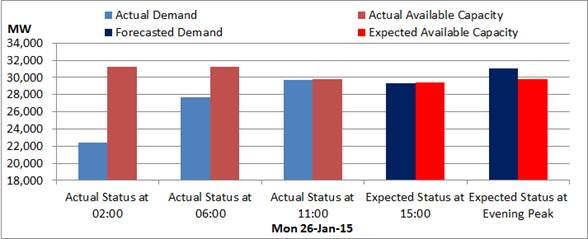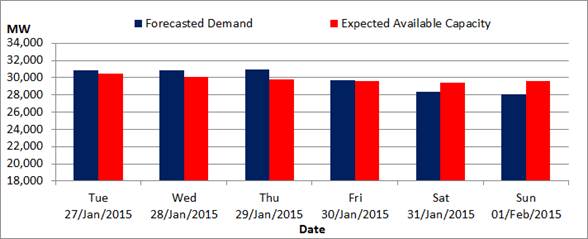Eskom implementing stage 1 of load shedding
Monday, 26 January 2015: The power system is severely constrained today due to unforeseen technical problems at power stations. As a result Eskom has had to go into stage 1 load shedding as of 11:00. This will continue until 22:00 this evening.
Eskom calls on consumers to urgently switch off geysers, air conditioners, pool pumps and all non-essential appliances throughout the day to reduce electricity demand. As workers leave office buildings this evening we ask that they please switch off the lights, with the exception of security lighting and avoid leaving on air-conditioning overnight.
Commercial customers, particularly shopping centres and office blocks, can make the biggest difference by switching off non-essential lights and not to leave office equipment such as photocopiers and computers in standby mode after hours.
In the event that load-shedding becomes necessary, Eskom will use the published load shedding schedules which are available on the Eskom website (http://loadshedding.eskom.co.
Eskom will provide regular updates on the status of the power system through all media platforms.
SYSTEM STATUS BULLETIN No. 315
Monday, 26 January 2015: Today Eskom releases its 315th update on the state of the power system. Eskom's system status bulletin is released twice a week in line with its commitment to regular and transparent communication on the power system, which is expected to be constrained for the foreseeable future.
Eskom had to go into stage 1 load shedding as of 11h00 today as a result of system constraints and unforeseen technical problems at its power stations. Load shedding moved from stage 1 to stage 2 at 15h00 and will continue until 22h00 this evening.
The power system remains constrained and will remain so for the rest of this summer. Any extra load or faults in the system may necessitate the need to go into load shedding.
Eskom calls on consumers to urgently switch off geysers, air conditioners, pool pumps and all non-essential appliances throughout the day to reduce electricity demand. As workers leave office buildings this evening we ask that they please switch off the lights, with the exception of security lighting and avoid leaving on air-conditioning overnight.
Commercial customers, particularly shopping centres and office blocks, can also make a big difference by switching off non-essential lights and not leaving office equipment such as photocopiers and computers in standby mode after hours.
Eskom customers can check load shedding schedules on the Eskom website (http://loadshedding.eskom.co.

Trends in the supply and demand of power in South Africa are as follows:
Today (Monday 26 January): The capacity available to meet this evening's peak demand is 29 747 MW (including open cycle gas turbines) while demand is forecast 31 028 MW. Current planned maintenance stands at 3 429 MW. Unplanned outages are 10 515 MW.
Peak demand and available capacity for the rest of this week is forecast at (please note that these are estimates and will likely differ from the actual figures):
Tuesday (27 January): The capacity available to meet tomorrow's evening peak demand is 30 427 MW (including open cycle gas turbines) while demand is forecast 30 857 MW.
Wednesday (28 January): The capacity available to meet that evening's peak demand is 30 095 MW (including open cycle gas turbines) while demand is forecast 30 842 MW.
Thursday (29 January): The capacity available to meet that evening's peak demand is 29 775 MW (including open cycle gas turbines) while demand is forecast 30 921 MW.
Friday (30 January): The capacity available to meet that evening's peak demand is 29 585 MW (including open cycle gas turbines) while demand is forecast 29 692 MW.
The demand in electricity generally tends to decrease over the weekend. The capacity available from Saturday to Sunday is therefore expected to meet the forecasted demand as follows (please note that these are estimates and will likely differ from the actual figures):
Saturday (31 January): The capacity available to meet that evening's peak demand is 29 425 MW (including open cycle gas turbines) while demand is forecast 28 336 MW.
Sunday (1 February): The capacity available to meet that evening's peak demand is 29 643 MW (including open cycle gas turbines) while demand is forecast 28 086 MW.
Yesterday (Sunday 25 January): Peak demand of 28 345 MW met by available capacity of 29 959 MW (including open cycle gas turbines).
Saturday (24 January): Peak demand of 28 645 MW met by available capacity of 30 775 MW (including open cycle gas turbines).
Friday (23 January): Peak demand of 29 204 MW met by available capacity of 31 977 MW (including open cycle gas turbines).
Thursday (22 January): Peak demand of 30 446 MW met by available capacity of 32 905 MW (including open cycle gas turbines).

Eskom continues to make progress with its programme of planned maintenance but the system remains tight. We urge all South Africans to partner with us to save 10% of their electricity usage throughout the day. This will make it significantly easier to manage the power system during this challenging time, while also enabling us to do planned maintenance to ensure the reliability of our plant. For tips on how to trim 10% off your consumption, visit http://www.eskomidm.co.za/
Statement issued by Eskom, January 26 2015
Click here to sign up to receive our free daily headline email newsletter

